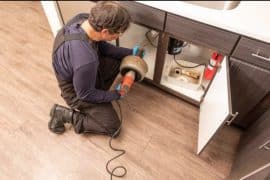Introduction
Drain cleaning is an essential aspect of plumbing maintenance that often goes unnoticed until a problem arises. Clogged drains can disrupt our daily routines and lead to messy backups, foul odors, and potential damage to your plumbing system. In this comprehensive guide, we will delve into the art of drain cleaning in plumbing. We will explore the techniques, tools, and tips that professional plumbers use to keep drains clear and prevent plumbing headaches.
I. The Importance of Drain Cleaning
1.1. Preventing Blockages
Regular drain cleaning is crucial for preventing blockages in your plumbing system. Over time, hair, soap scum, grease, food particles, and other debris can accumulate in drainpipes, leading to clogs. Preventative cleaning removes these potential obstructions, ensuring that wastewater flows smoothly.
1.2. Avoiding Foul Odors
Clogged drains can trap stagnant water, creating an environment for foul odors to develop. By keeping your drains clean, you can eliminate unpleasant smells that may emanate from your sinks, showers, or tubs.
1.3. Extending Drain Lifespan
Neglecting drain cleaning can lead to premature wear and tear on your plumbing system. Clogs and blockages put additional strain on pipes and fixtures, potentially shortening their lifespan. Regular cleaning can help maintain the integrity of your drains.
1.4. Preventing Costly Repairs
Clogged drains can lead to more significant plumbing problems, such as pipe damage or sewer line issues. By addressing drain blockages promptly, you can avoid costly repairs and emergency plumbing calls.
II. Drain Cleaning Techniques
2.1. Chemical Drain Cleaners
Chemical drain cleaners are readily available in most stores and are often the first line of defense against minor drain clogs. These products contain chemicals that dissolve organic matter and break down blockages.
Tips:
- Use chemical drain cleaners sparingly, as excessive use can harm your pipes and the environment.
- Always follow safety precautions when using chemical cleaners, including wearing protective gear and ensuring proper ventilation.
2.2. Mechanical Drain Cleaning
Mechanical drain cleaning methods involve physically removing clogs and blockages from pipes. Common mechanical techniques include:
- Plunging: A plunger creates a vacuum to dislodge minor clogs in sinks, toilets, and tubs.
- Drain Snake or Auger: These tools feature a coiled cable that can be inserted into the drain to break up and remove blockages.
- Hydro-Jetting: A high-pressure stream of water is used to clear out stubborn clogs and debris from drainpipes.
Tips:
- Properly trained professionals should perform mechanical drain cleaning to avoid damaging pipes.
- Hydro-jetting should only be performed by experienced plumbers, as it requires specialized equipment.
2.3. Natural Drain Cleaners
For eco-conscious homeowners, natural drain cleaners provide an environmentally friendly alternative to chemical products. Common natural drain cleaning solutions include baking soda and vinegar, which can help break down minor clogs and maintain drain freshness.
Tips:
- Pour a mixture of baking soda and vinegar down the drain, followed by hot water, to help clear minor clogs and eliminate odors.
- Consider using natural cleaners as a preventative measure to maintain clean drains.
III. Drain Cleaning Tools
3.1. Plungers
Plungers are a must-have tool for any homeowner. They come in various shapes and sizes, each designed for specific drain types. A cup plunger is suitable for sinks and tubs, while a flange plunger works best for toilets.
Tips:
- Create a tight seal between the plunger and the drain opening for maximum suction.
- Use a gentle, steady motion when plunging to avoid splashing.
3.2. Drain Snakes or Augers
A drain snake or auger is a flexible cable with a coiled end designed to break up and retrieve clogs from drainpipes. These tools come in manual and powered versions and are effective for more stubborn blockages.
Tips:
- Feed the snake or auger gently into the drain to avoid damaging pipes.
- Rotate the cable clockwise while advancing it into the drain to help break up clogs.
3.3. Pipe Wrench
A pipe wrench is an adjustable wrench with serrated teeth designed for gripping and turning pipes and fittings. It is essential for loosening and tightening plumbing connections during drain cleaning and repairs.
Tips:
- Use a cloth or a rubber pad between the pipe wrench and the pipe to prevent damage and provide a better grip.
3.4. Plumber’s Snake (Power Auger)
A plumber’s snake, also known as a power auger, is a motorized drain cleaning tool commonly used by professional plumbers. It features a rotating cable and cutting blades that can efficiently break up and remove stubborn clogs.
Tips:
- Plumber’s snakes should be operated by experienced plumbers to avoid damage to pipes.
- Ensure the snake is properly sized for the drain and clog type.
IV. Tips for Effective Drain Cleaning
4.1. Regular Maintenance
Preventative maintenance is key to keeping drains clean and clog-free. Implement these practices to maintain your plumbing system:
- Use drain strainers to catch hair and debris in sinks and tubs.
- Avoid pouring grease or oil down drains, as they can solidify and cause blockages.
- Run hot water down the drain periodically to help dissolve minor buildup.
4.2. Avoid Harsh Chemicals
While chemical drain cleaners can be effective, they should be used sparingly and as a last resort. Frequent use of harsh chemicals can corrode pipes and harm the environment.
4.3. Know When to Call a Professional
While many minor drain clogs can be cleared with DIY methods, some issues require professional attention:
- Persistent or recurring clogs.
- Foul odors that persist despite cleaning efforts.
- Slow drainage affecting multiple fixtures.
- Sewage backups or gurgling sounds in drains.
4.4. Prevent Frozen Pipes
In cold climates, prevent frozen pipes by insulating exposed pipes and allowing a slow trickle of water to flow from faucets during freezing temperatures.
Conclusion
The art of drain cleaning in plumbing is an essential aspect of maintaining a well-functioning plumbing system. Regular maintenance, effective techniques, and the right tools can help prevent clogs, extend the lifespan of your plumbing, and save you from the inconvenience of plumbing emergencies. While some drain cleaning tasks can be handled as DIY projects, it’s crucial to recognize when it’s time to call a professional plumber to address more complex issues. By taking proactive steps to keep your drains clean, you can ensure that your plumbing system operates smoothly and efficiently, enhancing your daily life and protecting your property from potential damage.


